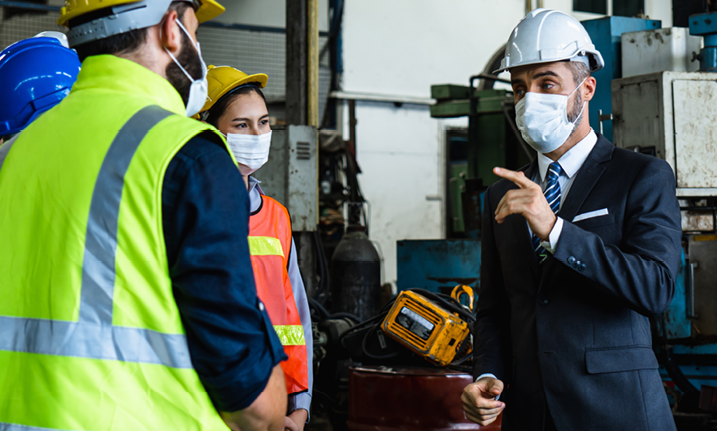

Most Australian states and territories have provisions for industrial manslaughter in their Work Health and Safety Act. Until recently, negligent employers could only be prosecuted for causing a workplace death under criminal law — and there were limitations to who could be prosecuted (and how).
In today’s blog we’re taking a closer look at how new industrial manslaughter laws impact your senior staff and management team — particularly if you operate in the mining sector. Use the contents in your next Rapid Induct module to help your workers understand their WHS duty of care. This is key to WHS compliance.
REMEMBER: the information contained in this blog is generalised, always check the specific work health and safety laws that preside in your actual state or territory.
What is industrial manslaughter
Industrial manslaughter occurs when a person dies at an Australian workplace due to negligence or recklessness. There are a number of factors which determine if industrial manslaughter applies:
1st Factor: The death must be workplace-related, even if it occurred after the negligence or recklessness.
Example
An employer did not provide proper PPE while handling carcinogenic chemicals and workers later died from chronic illnesses related to those chemicals VS a worker has a heart attack and dies at a mine site.
2nd Factor
The person responsible must have had a duty of care under state work health and safety legislation.
Example
A supervisor allowed a contractor to work at heights without fall protection VS an untrained apprentice watched a co-worker working at heights without having fall protection in place.
3rd Factor
The negligence that caused the death was done consciously or voluntarily.
Example
A manager instructed a subordinate to use an unsafe compressed gas cylinder (knowing it was out of test due to cost cuts) which exploded and killed someone VS the manager didn’t know that the cylinder was out of test.
4th Factor
There was actual negligence or recklessness.
Example
A worker maliciously damaged another worker’s PPE causing their death VS a worker killed while driving to a mine site and electing not to wear a seatbelt was a contributing factor.
IMPORTANT
These scenarios are generic examples for understanding and training purposes, they should not be applied to a workplace incident without specialised legal advice.

5 Key steps to WHS compliance
Industrial manslaughter occurs when people do not honour their duty of care to their employees, contractors, subordinates, or workmates. A fully compliant workplace (and mine site) has systems in place for addressing workplace hazards:
1. Build accountabilities into job descriptions
Ensure that everyone at the worksite — including the General Manager, Board of Directors, departmental managers, leading hands, direct employees and contractors understand their WHS duty of care.
There are 4 key elements:
Staying safe
Everyone on the mine site has a WHS responsibility to stay safe at work. This can involve everything from wearing seatbelts to using the PPE mandated in Safe Work Method Statements (SWMS) .
Not harming other people
Don’t do anything that could cause someone else to get hurt at work. This could be everything from asking a junior employee to do something that isn’t safe, or interfering with someone else’s safety gear.
Following instructions
Follow reasonable instructions. Even if it makes the job more time-consuming.
Comply with policies and procedures
Obey the rules of the mine site and perform job tasks according to SWMS.
Each of these accountabilities should be built into individual job descriptions and form the terms and conditions of employment/appointment.
2. Ensure inductions include WHS duties
Job descriptions are flat pieces of paper without training. Ensure that everyone who walks onto your mine site receives effective induction training that explains their WHS duty of care. This could be achieved through clear:
- Site rules
- Terms and conditions of employment
- Explaining the repercussions of not following procedures, such as demotion, termination of employment
- Real-world examples of workplace injuries and fatalities that occurred because procedures were not followed

3. Pay attention to management training
Pay close attention to the training of your managers and leading hands. They need all the inductions and training of a regular employee PLUS on-the-job coaching in management responsibilities.
REMEMBER: supervisors get nationally recognised training on how to coach others in job skills, but are you coaching your coaches?
Teach your managers and supervisors how to:
- Coach their sub-ordinates in job-skills.
- Ensure there are enough workers rostered to safely carry out the day’s tasks.
- Recognise the signs of fatigue.
WORKPLACE SAFETY TIP
Use Rapid Induct to create a management training module that includes all aspects of supervision, job coaching, and rostering.
4. Identify hazards and high-risk work
Identifying hazards and introducing risk control measures is a requirement of the WHS Regulation in every Australian state and territory. But to fully comply with this legislation make sure your workers (from top to bottom):
- Understand the hazards they will face in their daily work tasks.
- Know how to respond to hazards and create their own solutions
- Are confident to report hazards and unsafe work practices they encounter.
5. Report and investigate incidents immediately
Finally, an incident reporting and investigation system ensure that hazards don’t go unnoticed, and dangerous incidents are reported to the proper authorities. But it is more than a procedure to follow. It is a culture that (not only) welcomes and encourages incident reports, but is transparent in the incident investigation process. Everyone should know exactly what to do, when, and how.
WORKPLACE SAFETY TIP
Use Rapid Incident to log and track hazards and critical incidents. Once an incident has been reported, Rapid Incident allows you to isolate hazards, appoint an investigation team, and assign corrective actions.
Need help with your WHS compliance?
Did you know that Rapid Global offer high-end workplace management software that incorporates all aspects of WHS inductions and training, risk management, incident reporting as well as contractor management, site entry and visitor sign-ins?
It’s the perfect software for mining industry applications. Get in touch with our expert team today and request a free demonstration and a personalised solution for your industrial mine site.







